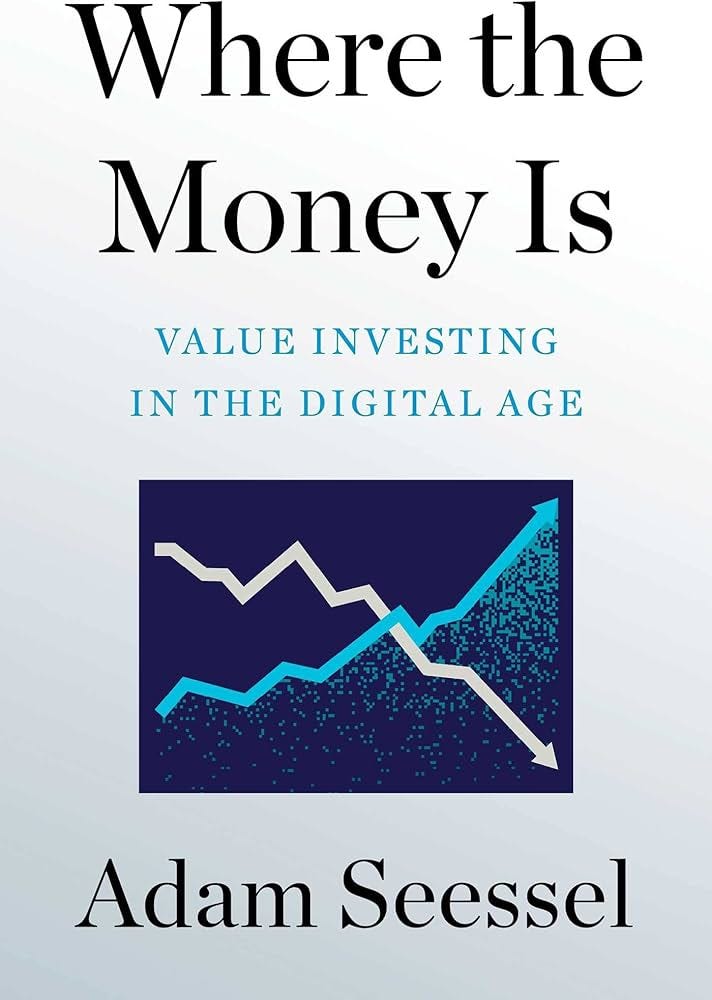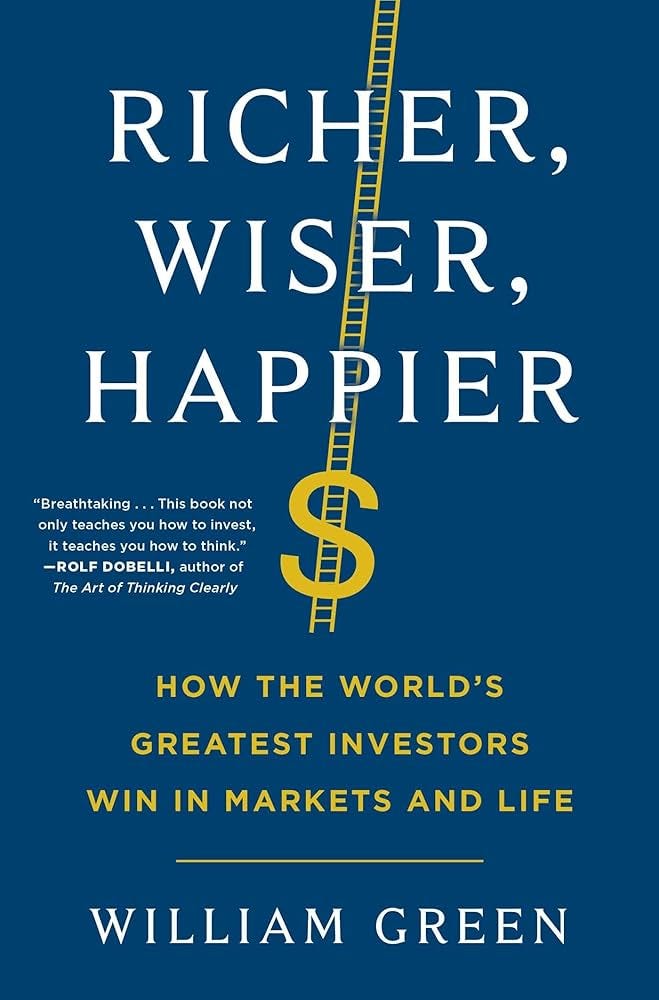Books are always informative, but some books can be transformative.
In today’s light pre-Christmas episode, I’ll walk you through:
3 Investing Books
3 reasons why you should read them, specifically in 2025
3 quotes for each of them
If you’re new, don’t miss out some of my recent updates:
📖 YTD Portfolio Results (latest Diary episode)
Let’s go!
3. Mastering the Market Cycle
Author: Howard Marks
Year: 2018
Long-time readers may be surprised of this choice.
In fact, I always preach how our job is to find excellent businesses that will produce strong earnings across any economic cycle.
Yet, this book earns its place today in light of the specific moment we are about to navigate in 2025.
📖 Why you should read it in 2025
A reminder of stock market cyclicality
Just like how the weather moves in cycles, economy, companies and markets move in cycles too. What is more, human psychology brings things too far, whether through excessive optimism or crushing pessimism, amplifying the highs and lows.
Speaking of cycles, we have had two consecutive years of exceptional returns for the US equity markets, with the S&P500 hitting roughly 25% both years. You know what I’m about to write, so I won’t.
It’s all about seeking favorable odds
Marks underlines the idea whereby predicting the direction of the market is impossible. Trying to anticipate macroeconomic trends and short term price action is a losing game.
Instead, we should try our best to understand where the odds are. By grasping the current phase of the cycle, we can position ourselves strategically and act in alignment with the most probable outcomes.
Skepticism and pessimism aren’t synonymous. Skepticism calls for pessimism when optimism is excessive. But it also calls for optimism when pessimism is excessive.
Alpha and Beta: everything you need to know
Mark’s 4 quadrants of the investor’s performance have been very useful to evaluate my performance and especially set expectations for the immediate future.
Essentially, the framework is telling us that we can do in line, better, or worse than the market based on two key elements: skills (alpha) and beta.
When the market goes well, we should generate alpha and position aggressively on beta to maximize our returns. Vice-versa, when the market flips negative, we should adjust our beta on the way down, while preserving outperformance with alpha.
Careful readers may have noticed how reducing my overall beta is one of the main goals for 2025. This explains why.
Now, you’ve cut your beta and prepared for bad times (…)
2. Where the Money is
Author: Adam Seessel
Year: 2022
Here comes one of my top choices.
I consider it an essential addition to your investment library, one that I can confidently say has transformed my investing approach.
Here’s why it stands out.
📖 Why you should read it in 2025
From value investing to quality investing
in the first part of the book, A. Seessel superbly summarizes the history of value investing from the early stages to modern days.
But he does way more, as he’s probably one of the pioneers of quality equity investing, as he clearly goes beyond traditional old-school value investing. How? He does it by emphasizing the importance of quality business fundamentals over valuation.
He proves how the excess returns of cheap stocks has dramatically decreased from the value investing 1.0 era until 2018. Today, in contrary, buying low-multiple stocks can do more harm than good by significantly exposing you to the risk of value traps.
No longer would I put price ahead of business quality as I had with Avon, Tribune Media, and the rest. Instead, I would search for businesses with superior economic characteristics, then see about price later.
Go beyond accounting rules and master the art of earnings power
The author brilliantly highlights the limitations of traditional accounting principles when applied to technology companies. Often, tech firms look way too expensive when evaluated solely on conventional valuation multiples.
This is because critical innovation-driven expenses, mainly R&D and marketing, are treated as immediate costs rather than investments that build future earnings power.
These expenses, unlike capital expenditures, cannot be capitalized under standard accounting rules. As a result, they can obscure the true profitability and long-term potential of high-growth tech businesses.
Recognizing this nuance has become an essential step even in my personal valuation process in order to accurately deal with not only tech companies but growing businesses in general.
Earnings Power is neither a profit forecast nor an earnings estimate. Instead, it attempts to quantify a digital company’s latent, underlying ability to generate profits.
Let your investing framework guide you
In the central chapters of the book, the author introduces his ‘BMP’ framework: Business, Management, Price. This structured approach involves a detailed checklist of criteria that every potential investment must satisfy to earn a high enough score for consideration.
Beyond the specifics of the framework itself, the lesson is clear: a systematic and disciplined process is essential for quality equity investing. A robust framework provides direction, saves time, and significantly reduces the risk of costly mistakes.
By relying on a proven process, investors can make rational, informed decisions rather than being fooled by emotions or market noise.
Price is the least important factor in Value 3.0 because allowing it to drive our research process is allowing the wrong dog to lead the hunt (…). A price-first mindset directs us to businesses not because they are good but because they are cheap. (…) Good businesses grow over time; isn’t it better to own them?
1. Richer, Wiser, Happier
Author: William Green
Year: 2021
This might just be my favorite investing book.
More than just an investing guide, it feels like a book for life. It’s a wonderful window into the minds and lives of legendary investors.
Through William Green’s interviews, readers gain a rare glimpse into their thoughts, habits, and philosophies, making this book a treasure of wisdom and life lessons.
📖 Why you should read it in 2025
Minimize mistakes, before seeking 10-baggers
The final chapter of the book offers an illuminating dive into the mind of Charlie Munger. One lesson shines above the rest: Don’t make stupid mistakes.
If your goal is to stay in the investing game for decades, minimizing costly missteps is far more critical than chasing a high winners-to-losers ratio.
Always focus on protecting your downside first, and only then start considering your potential upside.
I don’t have any wonderful insights that other people don’t have. I just have slightly more consistently than others avoided idiocy.
Other people are trying to be smart. All I’m trying to be is non-idiotic.
C. Munger
Don’t be afraid of Concentration: embrace it
Each legendary investor featured in the book has their own style and preferences when selecting companies. But there’s one unifying trait: concentration.
They exhibit the discipline to say “no” to 99% of companies, saving their “yes” for only the most asymmetric opportunities.
And when they do act, they do it with unwavering conviction. It’s once again a testament to prioritizing quality over quantity.
Make a small number of mispriced bets with minimal downside and significant upside.
Quality investing is a state of mind, a way of life
Another striking theme is how these investors’ personal qualities directly influence their investing approach, and vice versa.
The attributes that make them great investors, such as courage, vision, patience, balance, curiosity, and peace of mind, also permeate their daily lives.
To truly excel as a quality investor, you must cultivate these traits in every aspect of life.
In a world where nothing is stable or dependable and almost anything can happen, the first rule of the road is to be honest with ourselves about our limitations and vulnerabilities.
Accelerate your journey as Quality Investor
If quality equity investing is your favorite path to long-term wealth creation, and you want to learn and have fun along the way, but:
You lack the time to craft your own strategy
You are missing some parts of the process (valuation? business knowledge? information overload?)
Don’t feel enough confidence to manage your quality equity portfolio
→ You can steal my proven risk-first, market-beating framework.
Since 1-1-2021, the framework has generated a 36.5% CAGR, beyond my long-term realistic expectation of 15% CAGR, thus setting solid foundations for the future. But most importantly: it’s such a fun ride!
➡️ Request info for The Investor’s Edge, my 1:1 Mentorship Program, down below:
After the 3+ month program, you will get out with enhanced direction to win in equity markets and make the whole process fast, simple, fun, and reliable.
See you there.
📈
Meanwhile, thank you again for your valuable time.
Happy Investing,
Francesco - Business Invest








Great recommendations and great summaries. Thanks and happy holidays.
Hello, I’m genuinely impressed by the quality and depth of your content. It’s clear that you put a lot of thought into delivering value to your readers.
I’m excited to dive into your future emails as a new subscriber.
On a related note, I hope it’s okay to ask this here—are you open to a partnership? We can provide you with 1k subscribers.